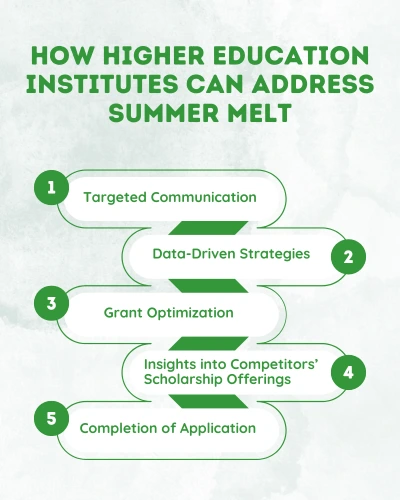How Higher Education Institutions Can Prevent Summer Melt
Every year, around 10% to 40% of high school students, particularly those from low-income backgrounds, intend to attend college but ultimately fail to do so. This phenomenon, where students commit to college but do not follow through, is known as summer melt.
Summer melt can occur for a variety of reasons, including financial challenges, lack of financial aid, feeling mentally unprepared for college, being overwhelmed by the complexities of the enrollment process, and more. Regardless of the cause, the rate of summer melt has increased by 20% to 30% over the past decade, becoming one of the most pressing concerns for higher education institutions in the U.S.
To address this issue, we will discuss solutions to help higher education institutions combat summer melt and improve student retention. Continue reading to learn more.
What is Summer Melt?
Summer melt is a phenomenon in which college-intending students who have committed to a college change their minds. They may either enroll at another college or decide not to pursue higher education.
Summer melt significantly impacts colleges and universities. Traditionally, colleges rely on deposits and commitments to predict enrollment rates for the upcoming class and plan their institutional budgets accordingly. However, with the rising rates of summer melt, higher education institutions are facing lost opportunities making it critical for them to address this issue promptly.
How Higher Education Institutes Can Address Summer Melt:
One effective approach to addressing summer melt is through Strategic Enrollment Management (SEM).
SEM is a comprehensive suite of analytical tools that can streamline an institution’s enrollment processes to increase student retention and improve net tuition revenue. It is a structured, proactive approach that keeps students engaged and supported. Let’s explore how it can help in combatting summer melt:
- Targeted Communication: SEM plays a crucial role in retaining students by fostering effective communication and engagement. By proactively interacting with targeted students on the verge of dropping out and addressing their questions during the admissions and enrollment processes, SEM helps keep students informed and connected. This continuous support ensures students stay engaged, ultimately reducing the likelihood of summer melt and enhancing retention rates.
- Data-Driven Strategies: With SEM, institutions can leverage custom predictive models designed to evaluate each student’s remaining financial needs and out-of-pocket expenses. These models identify students at the highest risk of summer melt. By analyzing a combination of factors such as individual stress indicators, historical retention trends, and traits of successful enrollees, the models provide deep insights into student vulnerability. Armed with this data, counselors can proactively engage with at-risk students through personalized outreach, addressing their specific challenges and concerns. This focused, data-driven strategy not only mitigates potential enrollment declines but also ensures that students receive the support they need to confidently transition into college life.
- Grant Optimization: SEM can help institutions evaluate the available parameters at the enrollment stage to determine the optimal grant for each student. The grant amount is then tailored to each student’s financial background, ensuring that aid is effectively allocated to those most likely to enroll and attend.
- Insights into Competitors’ Scholarship Offerings: A major factor contributing to summer melt is that many students select the college with the highest scholarship offer. With the help of SEM, institutions can gain valuable insights into competitors’ scholarship offerings tailored to specific student profiles, enabling them to strategically plan aid packages that foster better negotiation outcomes.
- Completion of Application: Another reason why a significant number of students do not join college is they feel overwhelmed in completing the application process. SEM can assist school counselors in seeing the status of each student’s application and guide them in taking the next steps to complete the application process.
Apart from SEM, several other strategies can help prevent summer melt. They are as follows:
- Inviting Students for Campus Visits: Inviting students for a campus visit can help prevent summer melt by reinforcing their connection to the college and making them feel more confident about their decision. Visiting the campus allows students to experience the campus culture firsthand, meet peers and faculty, and explore resources, which strengthens their sense of belonging. This engagement increases the likelihood they will follow through with enrollment, reducing the risk of them disengaging over the summer.
- Helping Students Navigate Financial Aid: By providing clear, timely information about financial aid packages, deadlines, and available support, colleges can reduce uncertainty and stress, making it easier for students to finalize their plans. Offering personalized assistance or guidance with financial aid applications helps ensure students feel financially secure and motivated to enroll, reducing the likelihood they will back out before the semester starts.
- Faculty Involvement: When faculty reach out personally or engage with students before the semester starts, it reassures them that they are valued and welcomed. Faculty can also provide academic guidance, answer questions, and highlight resources, helping students feel more prepared and confident about their college experience. This connection increases students’ commitment to attending and reduces the likelihood of disengagement over the summer.
- Special Discounts on Room and Boarding: Offering discounts, payment plans, or incentives for early commitment can encourage students to finalize their housing arrangements and feel more secure about their decision to attend. This financial relief can increase students’ confidence and motivation to follow through with enrollment, reducing the likelihood of them backing out before the semester begins.
Final Thought:
Preventing summer melt is a critical priority for higher education institutions and solutions like Virtue Analytics’ Strategic Enrollment Management suite offer transformative results. By proactively engaging students, addressing financial and procedural challenges, and leveraging predictive models to support at-risk students, SEM ensures a seamless transition to college. This data-driven approach not only reduces summer melt but also strengthens student retention and institutional revenue. Ready to transform your enrollment strategy? Contact us to learn how SEM can help your institution succeed.


